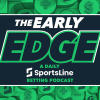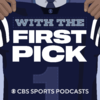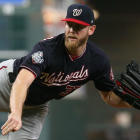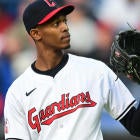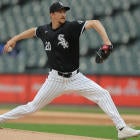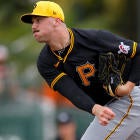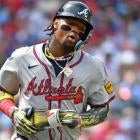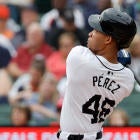Turns out Stephen Strasburg will pick up in 2020 where we last left him in 2019: with the Washington Nationals. The two sides agreed to a seven-year, $245 million deal Monday, making it, at least for the short time Gerrit Cole is still un-signed, the biggest free agent contract for any pitcher ever.
It's a big story, obviously, but when a free agent is filling a hole he himself created, there isn't as much to say about it. No ripple effect of jobs lost and jobs created. No park factor or supporting cast changes to consider. The potential impact is about as straightforward as it gets because, well, it's what we just saw.
But things have never been straightforward for Strasburg, have they? The most hyped pitching prospect in history, now 31 and set to begin his 11th major-league season, has so far put together a career that some might consider disappointing, relative to the hype. From the Tommy John surgery 17 starts in to shutting down to preserve his arm just before the Nationals' first ever playoff appearance to the myriad injuries that have come in the years since, he hasn't exactly established himself as a trustworthy option.
Yet here the Nationals are placing uncommon, even historic, trust in him.
But should you do the same in drafts this spring? In an era when aces aren't in short supply and yet the consequences for whiffing on one are steeper than ever, why should Strasburg get any benefit of the doubt?
The timing works in his favor, for sure. If he wasn't coming off maybe the best season of his career, complete with an MVP-winning World Series performance, he wouldn't have gotten the contract he just got. And in the interest of fairness, one could argue Strasburg has had better seasons. In terms of percentages — as well as ERA, FIP, WAR and Cy Young finish — that's undeniably true. But delivering ace production over an ace workload isn't something we've seen from him much. His 2019 represented only the second time he ever reached the 200-inning threshold, which is the sort of the minimum expectation for an ace.
| ||||||||||
The innings combined with a career-high 18 wins made him the fourth-best starting pitcher in both points and categories league — by that standard, clearly an ace. But the year was an outlier for Strasburg, and just because a performance falls within the range of possible outcomes doesn't mean it's the new baseline.
Still, projecting players — as in plotting possible outcomes and weighing risk vs. upside — is mostly about making an educated guess with the information available to us, and we do have more information available to us today.
Heading into the offseason, the likelihood of Strasburg repeating something close to his 2019 production hinged primarily on these three questions:
- Have his circumstances changed?
- Will he stay healthy?
- Has he legitimately gotten better?
Well, we know now the answer to the first one: no. He's back with the Nationals. The Nationals are mostly the same team that just won the World Series. Getting Anthony Rendon back would help, but not enough that Strasburg's ranking depends on it.
The health question is an eternal one. People smarter than me have figured out how to quantify a good many things, but there's still so much mystery to the human body, particularly when you account for everybody's physiology being different, that I don't think we're particularly close to cracking that nut. Strasburg proved in 2019 that he's indeed capable of throwing 200-plus innings, and I do believe that's one measure for which having done it is the best indicator of whether a player can do it.
Unfortunately, having gotten hurt in the past may be the best indicator for whether a player will get hurt in the future, and Strasburg is indeed no stranger to the IL, having served eight stints in the eight years since his Tommy John surgery. So while it's not a forgone conclusion he'll serve an IL stint at some point in 2020, it's the most reasonable expectation.
Which brings us to the third question of whether he legitimately improved in 2019, and for that, I can offer a more decisive answer: yes.
One point that tends to get lost in the narrative of Strasburg as perennial disappointment, which has mostly focused on health, is that the actual performance was beginning to slip. His ERA in three of the previous four seasons wasn't up to ace standards — a stark reality for a pitcher consistently falling short of an ace workload — and it was especially pronounced in 2018, when he produced a career-worst 3.72 ERA, 3.62 FIP and 1.20 WHIP. He was giving up harder contact in an era when hitters are optimizing for hard contact, and since it was happening at a point in his career when his fastball was beginning to decline, it had the potential to unravel him.
But he adjusted in response to it, going back to making the curveball his primary breaking pitch while also recapturing the feel for his two-seamer. Both pitches helped to make him such a hyped prospect in the first place, but the emphasis on bat-missing in the years since kind of steered him away from them. Getting hitters to put the ball on the ground more is one way to survive in the juiced ball era, though, and that's exactly what Strasburg did in 2019, delivering the best ground ball-to-fly ball ratio of his entire career and the seventh-highest ground-ball rate in all the majors.
Elite ground-ball tendencies have helped make pitchers like Marcus Stroman and Mike Soroka what they are, so to see Strasburg rank alongside them is noteworthy, if nothing else. But here's what pushes him over the top: It didn't compromise his bat-missing ability. In fact, he delivered the best swinging-strike rate of his career — a career that has yielded a 10.6 K/9 rate over 10 seasons, mind you — and only one other season came close.
So for Strasburg to reach new heights in the two areas by which a pitcher can best prevent a home run barrage in today's power-laden environment, and to do it through deliberate and measurable changes to his arsenal, I think shows legitimate growth for a pitcher who has long seemed like he had more talent than he knew what to do with. After years of tinkering, he may have finally figured it out.
If you accept that answer to the third question, then we're left with only the health one. And looking at the pitchers I rank just ahead of Strasburg, none of Mike Clevinger, Shane Bieber, Jack Flaherty and Walker Buehler has an established history of durability. Meanwhile, the pitcher I rank just behind Strasburg, Clayton Kershaw, has had his own troubles taking the mound in recent years.
Even acknowledging the risks, I'm comfortable having Strasburg as a top-10 starting pitcher, which in the strictest Fantasy Baseball sense would indeed make him an ace. Not Gerrit Cole-level, granted, but the dollars will soon enough reflect that.



